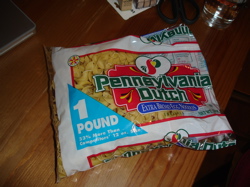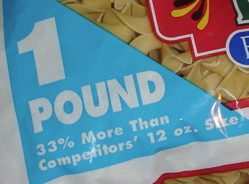The size of a pound of egg noodles
Check out my noodles. They’re bigger than your noodles.
Want to set up a wiki really easily?
 I just set up a wiki in perhaps a little more than 12 seconds, for our class, using pbwiki. Highly recommended for wikis for all occasions!
I just set up a wiki in perhaps a little more than 12 seconds, for our class, using pbwiki. Highly recommended for wikis for all occasions!
“It’s as easy as a peanut butter sandwich.” (And has the added benefit of making me hungry.)
Thanks to K for this recommendation… she says she uses it for her personal notes for work, and she can edit them anywhere she has an internet connection. A great idea.
Feelings of Punjab
Tonight for dinner I had Trader Joe‘s Punjab Eggplant, which had the distinct characteristic of spiciness that makes my throat itch. There should be a name for food with this trait… spitchy? prickled? irritasty?
“Helvetica rejected Sonic Youth.”
I just had the pleasure of watching Helvetica, a film about the font, typography, and the wide range of deep responses we can have to the way we write our letters in space. It is a great movie; go see it if you can.
Director Gary Hustwit was there with us, answering questions after the show. The funniest part was him describing how he got the music for the film (“What does Helvetica sound like??”), most of which was straight from the iTunes playlist he was listening to at the time he conjured up the idea for the film. (Think Four Tet, Caribou, Sam Prekop.) He’s got a background producing music documentaries, so has plenty of connections.
Hustwit says he even got five unreleased, instrumental tracks from Sonic Youth, for him to use in the film. But the tracks just wouldn’t fit, no matter how hard he tried. “Helvetica rejected Sonic Youth.”
The way that this statement makes so much sense is… indescribable to me, and utterly satisfying.
Eating dinner at the Museum of Science
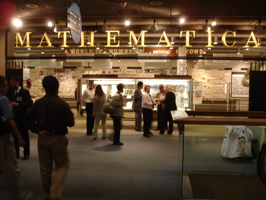 Last night’s catered Media Lab sponsor dinner was at the Museum of Science. I can’t tell you how funny it is to be playing with an exhibit, pressing buttons to adjust the speed of an animated school of fish, and have someone step up to you with a tray of treats and say, “Spanakopita bite?”
Last night’s catered Media Lab sponsor dinner was at the Museum of Science. I can’t tell you how funny it is to be playing with an exhibit, pressing buttons to adjust the speed of an animated school of fish, and have someone step up to you with a tray of treats and say, “Spanakopita bite?”
My favorite exhibit, hands down, is the “Mathematica” exhibit, which, I just learned, was designed by Charles and Ray Eames. Figures.
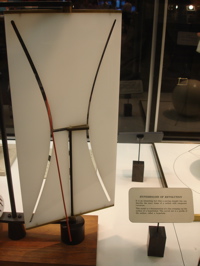
My favorite part of that exhibit is the Hyperboloid of Revolution. It’s beautiful and elegantly simple. (short video — 6.5 MB)
The sign says:
HYPERBOLOID OF REVOLUTION
It is an interesting fact that a moving straight line can describe the exact shape of a surface with compound curvature.
This model is a demonstration of a line sweeping out the surface of a hyperboloid. The curved slot is a profile of the surface, called a hyperbola.
Preparing for the Thesis
This afternoon was 3.5 hours of “rapid-fire”, “elevator-pitches” in the Media Lab’s Thesis Preparation course. So all 33 of the 2nd-year Masters students presented in 3 minutes what they hope to do for their Masters work this year.
The best part of an activity as draining as this is to walk away from it knowing that tons of awesome stuff is going to happen in the lab this year.
Here are some of the projects we can all look forward to:
- Programmable Matter — little cube automata that can be programmed to move relative to each other with electromagnetics.
- Cross-cultural Music Transformation — a translator for one culture’s musical style into another.
- Hi-Res, Low-cost Holographic Video
- “Comm.unity” — A platform that learns our social relationships and uses those to enable easy transfer of data between mobile devices in our social network.
- “Intelligent Stickies” — ink recognition, location awareness, and commonsense knowledge in Post-its.
- Investigating the placebo effect in active medicines — How does the packaging/branding change the effectiveness of a drug?
- Transforming digital content as it is copied and shared. Exploring making digital media more like analog media, which bears traces of previous usage.
- Wearable, wireless sensing for sports medicine, specifically for baseball pitchers.
- “E15” — a new way to browse the web.
- A digital platform for creation of interactive art in a networked environment.
- Persuasive Robotics — How can robots affect our attitude and behaviors? How is robot-human interaction different from human-human interaction?
“Visual Music” lecture
I gave my first lecture today. It was a 2.5-hour class on visualizing music, part of the Musical Aesthetics & Media Technology class I am TA-ing.
I spent much of the last few days preparing for this, and I found some impressive examples of visualizing music from the past few hundred years. In fact, there were so many examples that one of the hardest parts of preparing for the talk was defining its scope. I chose the examples I thought were most relevant to telling my version of the story, including Klee, Kandinsky, Oskar Fischinger, the Whitney brothers, Fantasia, all the way up to Ratatouille, the Music Animation Machine, and Martin Wattenberg’s The Shape of Sound. You can see all of these here, in my presentation:
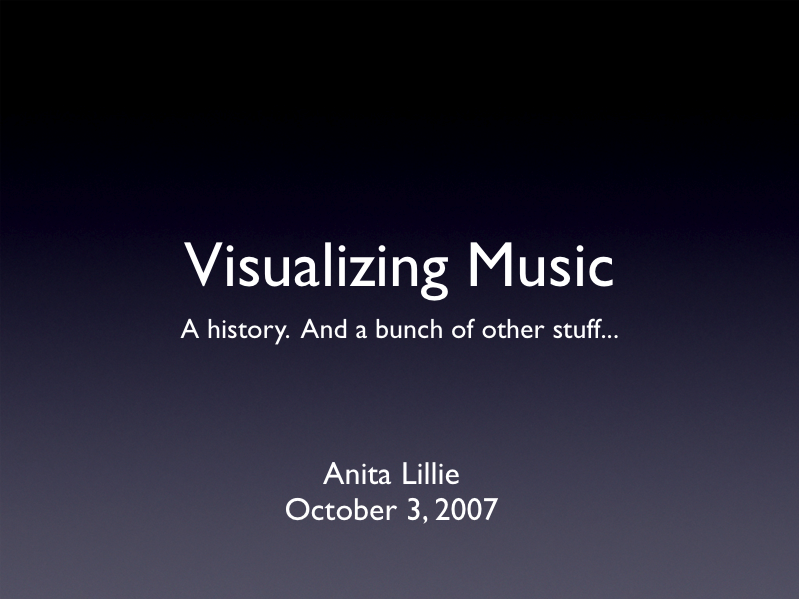
Click image above to download interactive QuickTime slideshow (4.2 MB)
Underlined texts are link-outs, and you can use arrows to navigate through the show.
My favorite example of all is Oskar Fischinger’s Allegretto, which blew me away. Unfortunately I can’t find this online, but there is a fantastic DVD with that video available here.
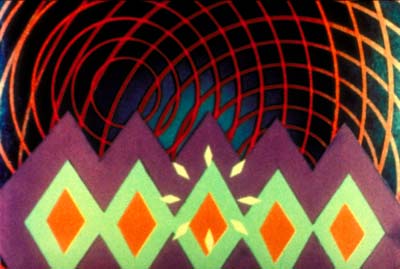
(Tomorrow or Friday I will follow up with a set of links that cover the best examples of visual music that I found, including a couple of killer blog finds. That set will be much larger than what I was able to cover in class today.)
